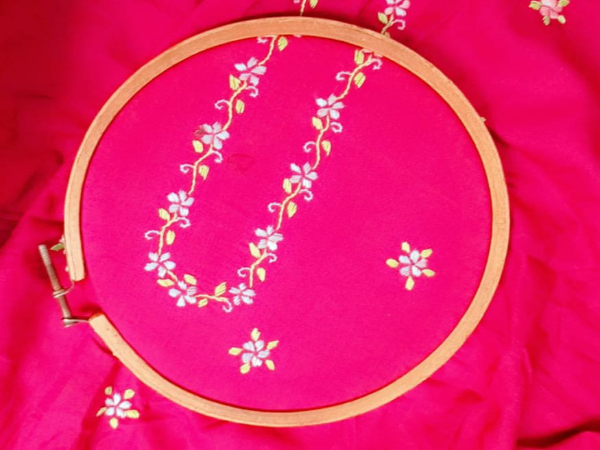Embroidery Embroidery Hoop: The Complete Guide to Mastering This Essential Tool
Unlocking Creativity and Precision with the Right Hoop for Your Needlework

An embroidery embroidery hoop is a circular frame, usually made of wood, plastic, or metal, that keeps fabric stretched tight while stitching. By holding the material firmly in place, it ensures neat stitches, prevents puckering, and gives both beginners and experienced embroiderers better control. Available in different sizes, shapes, and materials, embroidery hoops are an indispensable tool for anyone looking to create beautiful, professional-quality needlework.
Introduction
Embroidery has been practiced for centuries, admired as a combination of creativity, patience, and skilled craftsmanship. At the heart of this timeless art form lies a simple yet powerful tool — the embroidery embroidery hoop. Although small in appearance, this device transforms the stitching experience, making designs neater, cleaner, and easier to manage. Whether you are new to needlework or a seasoned stitcher, understanding the use, types, and benefits of embroidery hoops can take your craft to the next level. This comprehensive guide explores everything you need to know about embroidery hoops, from history and types to expert tips on choosing and using them effectively.
The History of Embroidery Hoops
Early Beginnings
The concept of holding fabric under tension dates back hundreds of years. Ancient artisans used wooden frames and stretched cloth across them to ensure a stable surface for decorative stitching. Early versions were simple, often handcrafted tools that made embroidery more manageable.
Evolution Over Centuries
As embroidery spread across cultures — from Asian silk stitching to European tapestries — the need for reliable fabric-holding tools grew. Large wooden frames were used for extensive projects like church textiles, while smaller circular hoops emerged for personal handwork.
Modern Developments
Today’s embroidery embroidery hoops are more refined, featuring adjustable screws, durable materials, and even stands for hands-free stitching. They represent the perfect blend of tradition and innovation, supporting both hobbyists and professional embroiderers alike.
Why the Embroidery Embroidery Hoop Is Essential
Consistent Fabric Tension
A hoop holds fabric tightly, preventing sagging or wrinkles. This ensures each stitch sits evenly, giving the finished design a professional look.
Neater and Cleaner Results
By reducing fabric movement, hoops eliminate puckering and distortion. This precision is especially vital for detailed patterns or counted techniques like cross-stitch.
Better Control for Beginners
For those new to embroidery, a hoop creates a stable work area. It reduces mistakes, making the learning process less frustrating and more enjoyable.
Versatility in Projects
From delicate monograms to large floral designs, hoops can adapt to almost any project. Their availability in different sizes and shapes makes them indispensable across styles.
Types of Embroidery Embroidery Hoops
Wooden Hoops
Description: Classic, lightweight, and often made from beechwood or bamboo.
Pros: Natural feel, smooth grip, and ideal for most fabrics.
Cons: May loosen over time without proper care.
Plastic Hoops
Description: Affordable, colorful, and durable.
Pros: Easy to clean, resistant to warping, often with strong grips.
Cons: Can feel slippery or less traditional in the hand.
Metal Hoops
Description: Sturdy and long-lasting, often used for heavy-duty fabrics.
Pros: Excellent durability and firm hold.
Cons: Heavier, sometimes uncomfortable for long sessions.
Spring Tension Hoops
Description: Use a metal spring inside a circular frame to snap fabric tight.
Pros: Quick and easy setup.
Cons: Less precise than screw hoops.
Flexi Hoops
Description: Made of flexible vinyl or plastic that stretches over the fabric.
Pros: Double as frames for displaying finished embroidery.
Cons: Not ideal for active stitching sessions.
Q-Snap Frames
Description: Square or rectangular frames with snap-on clamps.
Pros: Perfect for cross-stitch and larger designs.
Cons: Bulkier than traditional hoops.
Tabletop and Floor Stands
Description: Stands hold hoops or frames, freeing both hands for stitching.
Pros: Comfort during long projects and reduced hand strain.
Cons: Less portable.
How to Use an Embroidery Hoop Effectively
Prepare the Hoop
Loosen the screw on the outer ring so the two rings can separate easily.
Place the Fabric
Lay the inner ring flat, position your fabric over it, and then press the outer ring down.
Adjust Tension
Tighten the screw gradually, pulling the fabric gently around all sides until it feels drum-tight.
Secure and Start Stitching
Once the fabric is firmly in place, begin your embroidery. Re-tighten occasionally if the fabric loosens.
Prevent Fabric Marks
Remove or loosen the hoop when not stitching to avoid permanent creases on the fabric.
Tips for Choosing the Right Embroidery Embroidery Hoop
Match Size to Project: Choose a hoop slightly larger than your design for easy access without constant repositioning.
Check Material Quality: Look for smooth finishes that won’t snag threads or damage fabric.
Consider Depth: Deeper hoops are better for thicker fabrics, while shallow hoops work well for delicate cloth.
Hardware Strength: Brass or strong metal screws ensure long-lasting use.
Comfort: Test the weight and grip to make sure it feels good in your hands during long stitching sessions.
Benefits Beyond Stitching
Display and Decoration
Finished embroidery pieces can be displayed directly in the hoop. Many crafters decorate the edges with ribbons, paint, or fabric for a charming frame effect.
Teaching and Learning
For classrooms or workshops, hoops make embroidery accessible and easy for beginners to grasp.
Portability
Compact and lightweight, hoops make it simple to take projects anywhere — whether traveling or attending stitching groups.
Common Mistakes to Avoid
Over-tightening the Fabric: Can distort weave and cause long-term creases.
Using the Wrong Size: Oversized hoops are hard to manage, while too-small hoops require constant repositioning.
Leaving Fabric in the Hoop: Leads to stubborn marks and can weaken delicate materials.
Neglecting to Bind the Inner Ring: Wrapping with twill tape increases grip and prevents slippage.
Advanced Uses of Embroidery Hoops
Appliqué and Beading: Hoops stabilize fabric, making it easier to add embellishments.
Goldwork and Specialty Techniques: Essential for precision when working with metallic or delicate threads.
Mixed Media Projects: Hoops aren’t limited to stitching — they can be used as bases for dreamcatchers, floral wreaths, or wall art.
Caring for Your Embroidery Hoop
Wooden Hoops: Wipe clean and store away from moisture to prevent warping.
Plastic Hoops: Wash gently with mild soap if dirty.
Metal Hoops: Keep dry to avoid rust and polish if needed.
General Storage: Always store hoops flat in a cool, dry place.
Embroidery Hoops in Modern Craft Culture
With the rise of DIY culture and handmade crafts, embroidery hoops have become more than just tools. They are symbols of creativity, frequently seen in social media tutorials, craft fairs, and home décor trends. From simple monograms to elaborate wall art, hoops now represent both process and product in the world of needlework.
Conclusion
The embroidery embroidery hoop is far more than a circular frame — it is the foundation of neat, precise, and beautiful stitching. Its role in embroidery spans centuries, bridging tradition with modern creativity. Whether wooden, plastic, metal, or mounted on stands, hoops cater to every need and style. By choosing the right type, learning to use it correctly, and caring for it properly, you can elevate your embroidery projects to professional levels.
For beginners, hoops provide control and confidence. For advanced stitchers, they unlock precision and comfort. And beyond stitching, they serve as charming frames for your finished masterpieces. Truly, the embroidery hoop is not just a tool but an essential companion in the timeless journey of needlework.



